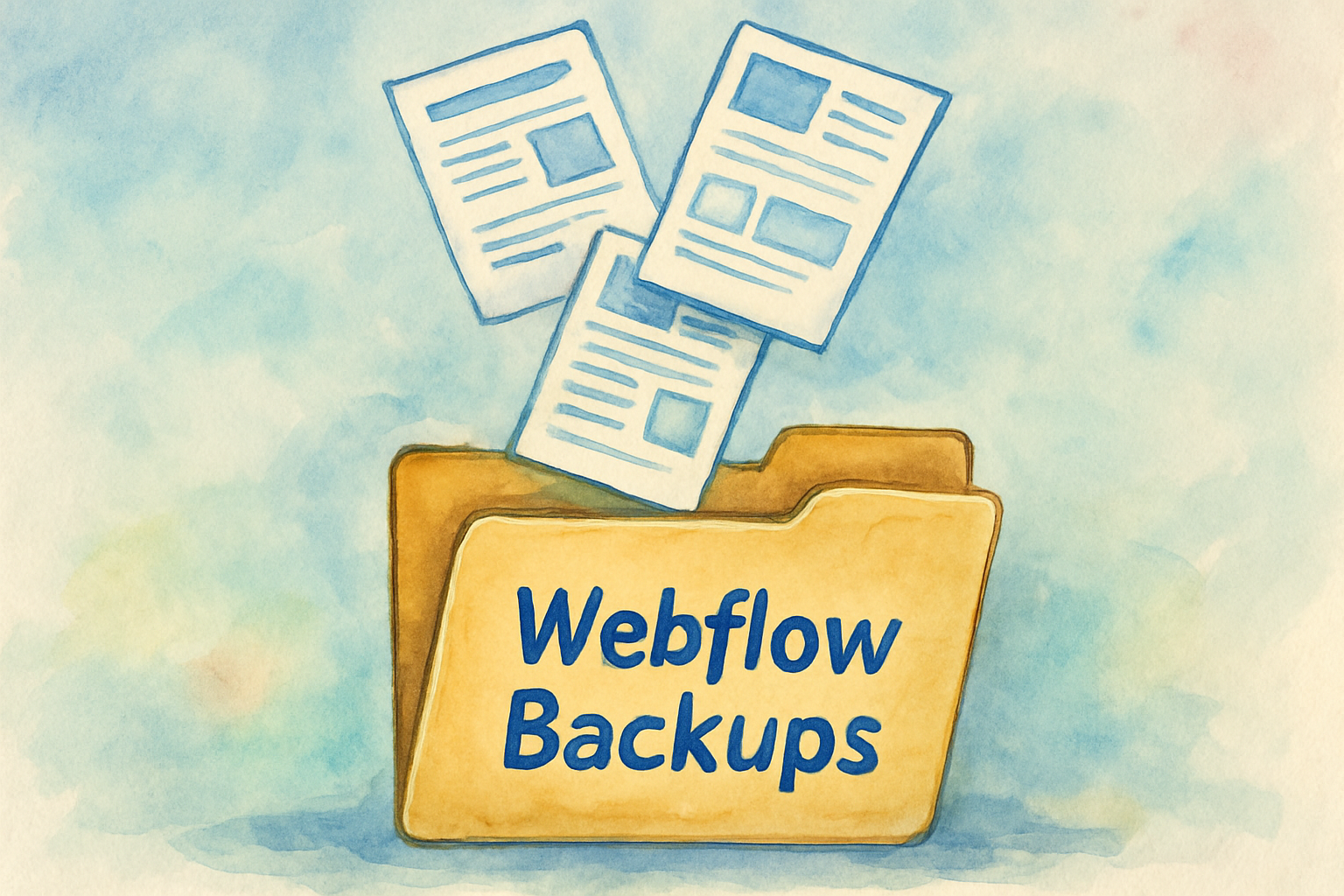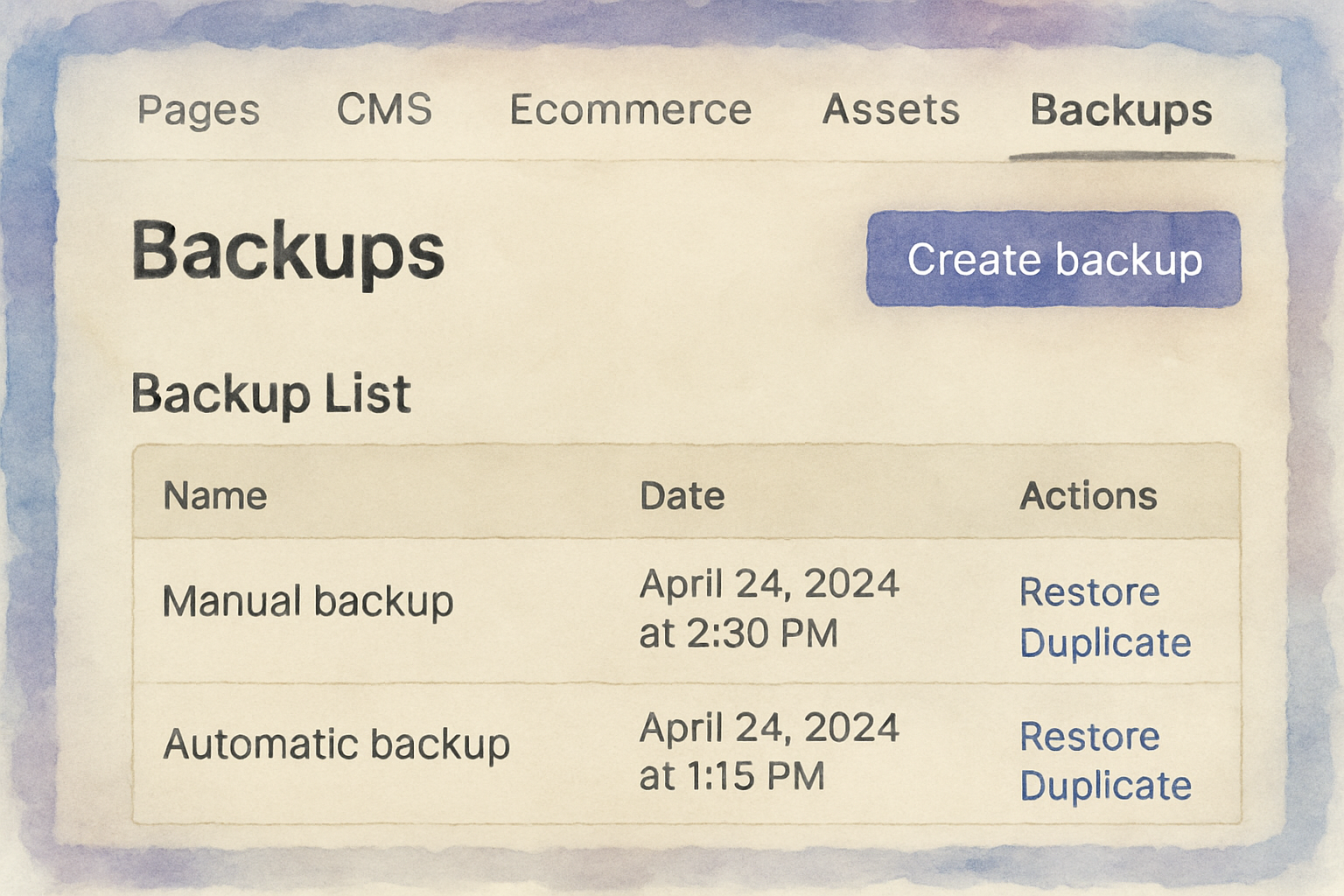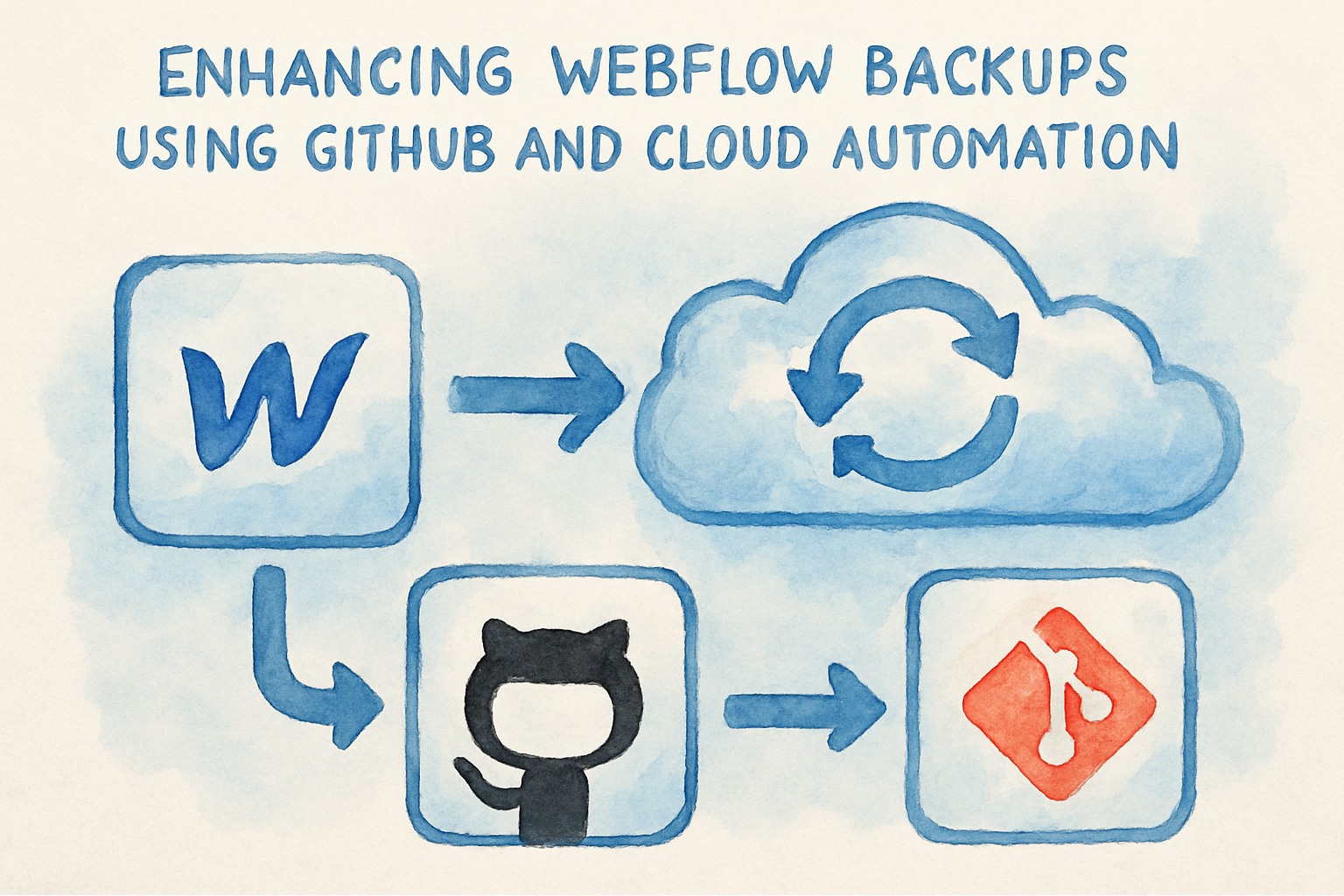Webflow backups are a fundamental part of maintaining a secure and sturdy website.
But what exactly are these backups, and how do they protect your project?
This article is your complete cheatsheet to mastering webflow backups in 2025.
Some are automatic, quietly saving your work in the background.
Some are manual, giving you control to create snapshots at key moments.
Some include your site's design and structure; others miss out on dynamic content nuances.
Some even offer integration with tools like GitHub and Zapier to supercharge your backup strategy.
Let's dive right in.
Table of Contents
- What Are Webflow Backups?
- Types of Webflow Backups
- How to Create and Restore Webflow Backups
- Limitations and Common Issues with Webflow Backups
- Enhancing Your Webflow Backup Strategy
- Best Practices for Managing Webflow Backups
- Frequently Asked Questions About Webflow Backups
- What’s Your Next Step?
What Are Webflow Backups?
Webflow backups are snapshots of your website’s current version saved to protect your work against loss or errors. They help you rewind your project to a previous state if something goes wrong, such as accidental deletion or faulty updates. As Webflow is a popular web design platform, understanding its backup system is crucial for website owners and developers alike.
Backups capture your site’s design, structure, CSS, and content to varying degrees, enabling efficient project recovery without starting from scratch. Webflow’s official help guide details how backups safeguard your website history, underscoring their importance for maintaining site stability.

Types of Webflow Backups
There are two main types of Webflow backups:
- Automatic Backups: Webflow automatically creates restore points every 20th autosave while you are designing your website. These happen frequently during active work sessions and less often when the site is idle. They capture essential changes to your site’s structure and appearance across all site plans from Starter to Enterprise, offering unlimited storage for backups — a significant advantage ensuring constant protection without user intervention. (Verified with sources as of 2025-08-12)
- Manual Backups: These allow you to create a backup snapshot anytime you want. For example, before a major redesign or deployment, manually saving a backup can provide peace of mind and a safety net. Creating one is simple: just press Shift + Command + S on Mac or Shift + Control + S on Windows, name your backup, and save. This gives greater precision and control over your backup history.
Both types work hand in hand. Automated backups keep you covered during regular work, while manual backups provide checkpoints for critical milestones.
Webflow Version Control System
Besides backups, Webflow features a version control system that logs significant updates, like publishing events, enabling a timeline of your work. This helps track changes over time and can be combined with backup restoration for robust site management.
Did you know? You can preview any backup in a read-only mode, so you can inspect old versions without affecting your current work.
How to Create and Restore Webflow Backups
Creating and restoring backups in Webflow is straightforward but worth mastering to ensure smooth recovery if needed.
Creating a Manual Backup
- Make sure you are in the Webflow Design mode, not Build or Editor.
- Look for the "Backups" icon in the top toolbar and click on it.
- Click the "Create Backup" button, name your backup meaningfully (e.g., "Pre-Redesign July 2025"), and save.
- Webflow quickly creates the snapshot, which appears in your backups list for easy access.
Alternatively, use the keyboard shortcut Shift + Command + S (Mac) or Shift + Control + S (Windows) to open the backup dialog instantly.
Restoring From a Backup
- Open the Backups tab in your Webflow project settings.
- Select the backup you want to restore. You can preview it before making a decision.
- Click "Restore Backup." Webflow creates a new backup of your current site before proceeding, ensuring safety.
- Once restoration is complete, remember to publish your site again to make the restored version live.
This process protects your current state before restoring another, giving you a fallback option if you change your mind.
Enabling and Publishing Locales
When restoring a backup, especially with multilingual sites, you may need to reenable certain locale settings to ensure that localized content publishes correctly. This requires revisiting your locales in settings and confirming publishing rights before republishing your site.

For a complete step-by-step tutorial on creating and restoring Webflow backups, watch the video below:
Limitations and Common Issues with Webflow Backups
While Webflow backups provide essential protection, it's critical to understand their limitations to avoid surprises:
1. CMS Export Restrictions
Automated backups do not capture CMS exports fully. CMS data exports only include dynamic content but exclude static content and custom code adjustments made in the Designer. This means some content changes may not be fully backed up internally. For comprehensive backups, manual CMS exports are recommended.
2. IDs and API Dependencies
Backups created before March 25, 2024, might change CMS Collection and item IDs when restored. This affects API calls or third-party integrations relying on those IDs. However, backups created after this date preserve the IDs, minimizing integration disruptions. (Verified with sources as of 2025-08-12)
3. External Integrations Are Not Backed Up
Webflow does not back up external API connections, third-party tools, or data stored outside its platform. This means you need a separate strategy to manage these critical assets.
4. No Scheduled Automatic Backups
Unfortunately, Webflow doesn’t allow scheduling automatic backups. Users must remember to create manual backups regularly, which can be error-prone and time-consuming.
5. Backup Retention Limits
Backups are kept for a limited period, especially for larger or older projects. Failing to export or save important backups externally may result in permanent loss after expiration.
6. Disruption on Restore
Restoring backups may temporarily disable APIs, forms, and third-party apps connected to your site. Adjustments such as ReCAPTCHA settings and inventory levels in eCommerce sites often require manual reconfiguration after restoration.
Quick Tip: Always test your integrations and custom scripts after a restoration to identify and fix any broken connections promptly.
Enhancing Your Webflow Backup Strategy
To overcome Webflow's limitations and create a rock-solid backup plan, many users complement Webflow’s native tools with third-party services.
Using GitHub for Version Control
GitHub is ideal for developers who want detailed tracking beyond Webflow’s built-in versioning. You can export your site’s code regularly and push it to a GitHub repository. This gives you:
- Robust version history
- Team collaboration features
- Change tracking and rollback options
The process involves exporting your site code, creating a GitHub repo, uploading code, and regularly committing changes — a powerful workflow that integrates well with Webflow projects. Source
Automate Backups with Zapier and Udesly
Tools like Zapier can automate backup-related tasks by connecting Webflow to cloud storage or backup services. Udesly is another useful platform tailored to boost Webflow capabilities and backup automation. These bridges reduce manual workload and improve your site's security strategy. Source
External CMS and Data Archives
Exporting CMS collections regularly and storing them externally is a crucial habit. This protects your dynamic content beyond Webflow’s native backup capabilities, critical for content-heavy or frequently updated sites.

Best Practices for Managing Webflow Backups
Building an effective webflow backup routine involves these essential tips:
Create Backups Before Major Changes
Always make a manual backup before big updates, redesigns, or integrations. This creates a restore point you can confidently revert to without losing progress.
Use Clear, Descriptive Backup Names
Label your backups with contextual names and dates, e.g., "Landing Page Update - Aug 2025" to avoid confusion when selecting versions later.
Regularly Export CMS Data
Export CMS collections separately, saving copies offline or in cloud storage to guard against data loss beyond Webflow’s scope.
Test Restorations Periodically
Perform test restorations on non-production projects to verify your backup process works smoothly and data integrity is retained.
Monitor Integration Health
After restorations, check that all APIs, third-party apps, and features like ReCAPTCHA and eCommerce inventories function as expected.
Keep Multiple Backup Copies
Use both Webflow backups and external solutions like GitHub or Zapier. Diversifying prevents single points of failure.
Plan a Backup Schedule
Although Webflow lacks automatic scheduling, set calendar reminders for manual backups, especially during active development phases.
Keep Your Site on Paid Plans
The backup feature is exclusive to paid Webflow plans. If on a free plan, manual backup workflows are even more vital though less convenient. Source
Frequently Asked Questions About Webflow Backups
Can I restore a backup without affecting visitors?
Restoring a backup affects the live version once published, so it's best done during low-traffic hours. Restorations may disrupt live APIs or forms temporarily, so prepare accordingly.
Does Webflow backup external integrations?
No. External APIs, third-party tools, and databases require your own backup solutions as Webflow focuses on site structure and CMS data.
How long are Webflow backups stored?
Backup retention depends on your project size and plan. Older backups can expire if not manually saved externally, so timely exports are recommended.
What happens if I restore an old backup?
The entire site returns to the state at the backup time, potentially erasing recent changes. Webflow protects you by auto-saving your current state before restoring, so you can revert if needed.
Can I schedule automatic backups in Webflow?
No. Scheduling is not supported natively; manual backups and third-party tools like Zapier help to automate the process.
What’s Your Next Step?
Tell us in the comments: How will you apply this to your webflow backups? For personalized advice, contact us!
Want to deepen your knowledge? Check out our comprehensive post on the ultimate guide to Webflow backups to further sharpen your skills.
And if you’re curious about how Webflow stacks up against other builders, don’t miss our detailed comparison in Webflow vs Wix: Guía definitiva para elegir tu constructor de sitios web.
Backup your site regularly and protect your online presence effectively with these proven strategies!